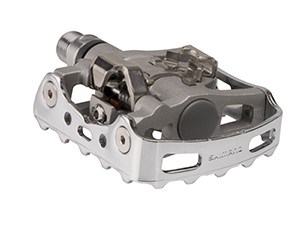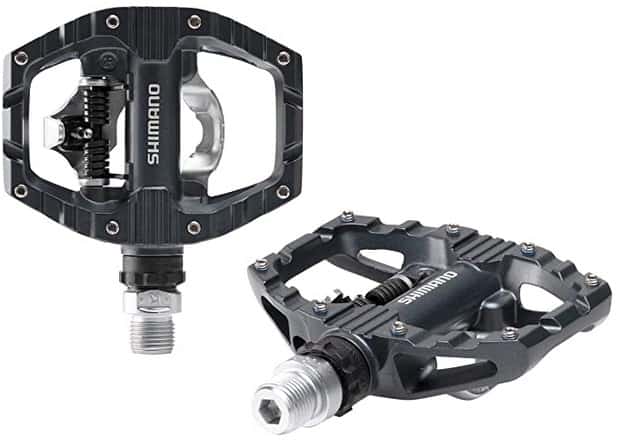Shimano Pedaling Dynamics (SPD) pedals are becoming the reference point for clip-less pedals. But how good are they? Are SPD pedals worth it?
SPD pedals are worth it because they firmly position your feet, and that gives you biomechanical advantages. In that case, you enjoy more climbing power, sprinting, and pedaling efficiency.
Additionally, the pedals protect your knees and improve your cycling comfort, as you’ll discover in this post.
I’ll explain all these advantages to help you understand my argument. I’ll also share the downsides that come with the pedals to help you decide if they are worth it.

In a rush? Check out my most recommended SPD pedals from Amazon below.
3 Best SPD Pedals For Cycling
1. Shimano SPD Pedal E-PDM520L: Best MTB SPD Pedals
2. Shimano PD M324 SPD: Best Road Bike SPD Pedals
3. Shimano PD-EH500: Best Multi-Use SPD Pedals
Are SPD Pedals Worth It? (4 Reasons to Consider them)
Here are the reasons why SPD pedals are worth it:
1. Better Control
SPD pedals allow you to position your legs firmly, making it easy to control your bike. Since you clip in your feet, they don’t slip easily, and that’s what makes the control effortless.
In general, you need exceptional foot stability to control a bike on technical terrain, and that’s what SPD pedals offer you. They allow you to concentrate on the trail ahead and not what’s happening to your feet.
2. Biomechanical Advantages
Since your feet don’t slip off easily, SPD pedals allow you to position them properly, and that gives you the following biomechanical advantages:
- Pedaling Efficiency
Considering that SPD pedals allow you to position your feet firmly, your feet and body become one harmonious unit. That means every stroke delivers more energy, and that makes it easy to cycle.
- Climbing Power
Given that you pedal more efficiently, you apply more power with each stroke, about 10% more. Overall, the more powerful you pedal, the likelier you are to climb and go over obstacles.
With climbing power, SPD pedals are better for mountain bikes.
- Sprinting Advantage
It also boils down to the pedaling efficiency when it comes to sprinting. The more powerful you pedal, the more you run. Generally, the pedals sprinting advantage makes them best for road bikes.
3. Knee Safety
Nowadays, most SPD pedals come with float adjustment to swivel your foot slightly and lock your knee in one position. Once you do that, it prevents possible knee injuries when you pedal hard.
4. Cycling Confidence
Usually, it takes time to master SPD pedals. But once you do, you become more confident. Your pedaling skill improves a lot, and it becomes easy to place your feet and pedal away.

When Are SPD Pedals Not Worth It?
As discussed, SPD pedals are worth it when you want to enjoy biomechanical advantages when taking on challenging terrains. That includes wet surfaces and rugged slopes.
The pedals assure you that your feet will stay in position, and that’s important in climbing and speeding.
But if you plan to commute short distances and get on and off the bike often, then SPD pedals are not worth it.
They are also not worth it if you intentionally plan to ride smaller miles.
What Are SPD Pedal’s Concerns?
Even though SPD pedals are fantastic in a lot of ways, as discussed, they come with the following concerns:
- Less Clearance
Sometimes, the pedals appear thicker, and if you add their thickness to that of your cycling shoes, you reduce the ground clearance. This may not be an issue on flat ground, but it’s likely a problem on a slope.
- Clogging Possibility
During a heavy downpour, SPD pedals clog easily with mud. They can also trap snows balls. As a result, they aren’t the best for extreme weather.
- Longer Learning Curve
Yes, SPD pedals allow you to pedal confidently and offer you biomechanical advantages. The problem is that it may take a longer time to master their use.
Overall, you may wait for a couple of months to effectively use SPD pedals.
Different Types of SPD Pedals.
Generally, clip-less pedals come in two primary systems, depending on the number of bolts that connect the cleats to the cycling shoes.
First, we’ve two-bolt pedals, which are considered the true SPD pedals, and the three-bolt options often known as the SPD-SL pedals.
More often than note, 2-bolt cleats relate to mountain bikes, while 3-bolt options are popular for road bikes.
Let’s discuss them:
1. Road Bike SPD Pedals
As I hinted, road bike pedals mostly feature the 3-bolt system. Such pedals usually are known as the SPD-SL (where the SL part stands for super light).
Overall, road cycling shoes have a much larger cleat, which necessitates three anchoring bolts.
Note, however, that even though 2-bolt cleats mainly relate to mountain bikes, there are a few road bike-specific 2-bolt SPD cleats. One such pedal is the Shimano PD M324 SPD.
The pedals come with two bolts that make them compatible with road cycling shoes. It also comes in an aluminum body that makes it lightweight and befitting road bikes.

2. Mountain Bike SPD Pedals
But like I mentioned, the term SPD refers to two-bolt pedals, which are often mountain bike pedals. These pedals are generally easy to clip in, which is essential when mountain biking.
Moreover, they offer you a secure hold, which is also necessary for mountain biking. That’s the case with the Shimano SPD Pedal E-PDM520L.
These clip-less pedals offer you a broad platform to enjoy better gearing, which is necessary for fast descending and steep climbing.
Their design also allows you to shift efficiently and accelerate when you change terrains.
3. Multi-Use SPD Pedals
Lastly, some SPD pedals come with dual platforms where one side offers you an SPD-specific clip while the other offers you a standard platform.
A perfect example here is the Shimano PD-EH500.
Its dual-sided platform offers you the convenience of a traditional platform pedal (on one side) and an SPD pedal (on the other side).
As a result, it’s a perfect multi-use SPD pedal that you can use for road cycling, mountain biking, commuting, urban cycling, among others.

FAQs
1. Do SPD Pedals Make Difference?
SPD pedals offer you about 10% more power on every stroke, which improves your pedaling efficiency, climbing power, and sprinting.
We call it having the biomechanical advantage, which is essential for serious cyclists and those tackling challenging terrains.
2. Are SPD Pedals Easier?
SPD pedals are much easier to clip in. More importantly, they offer you more pedaling leverage. You get to pedal with more power, which makes hill climbing and sprinting much easier.
3. Do SPD Pedals Wear Out?
No bicycle pedal is wear-resistant, and SPD pedals are no exception. So, yes, SPD pedals do wear out with time, more so after rough usage. For that reason, you need to replace them when you identify signs of wear.
4. Are SPD Pedals For Road Bike?
SPD pedals mostly suit mountain bikes because of their two-bolt cleat design. However, some SPD pedals are specifically for road bikes, and a perfect example is the Shimano PD M324 SPD.
Note, however, that road bike pedals are traditionally 3-bolt cleats, what we call SPD-SL.
5. When Should I Replace My SPD Pedals?
Once it becomes difficult to detach your foot from an SPD pedal, it’s advisable to replace it. Also, do it when you feel a slight slack or loss in your pedaling power and efficiency.
6. Are SPD Pedals More Efficient?
SPD pedals allow you to pedal with more power and do it quicker, thus more efficient than traditional pedals. They also allow you to use minimal effort when pedaling on technical paths.
7. Are SPD Pedals Dangerous?
It’s a misconception that clip-less pedals, especially SPD style, are more dangerous than regular pedals. That’s not true. Neither of the two is more dangerous than the other.
Your cycling safety mostly depends on how cautious you are. Note, however, that since clipless pedals allow you to adjust the float, you can prevent knee injuries, thus slightly safer than flat options.
8. What Is The Difference Between SPD And SPD-SL Pedals?
The SL part of the SPD-SL stands for super light. That means SPD-SL pedals are lighter than their SPD siblings.
The other difference is that SPD pedals have two bolts that anchor the cleats to the shoes while SPD-SL pedals have three.
It’s also worth noting that SPD pedals are more associated with mountain bikes while SPD-SL pedals are popular with road bikes.
9. Can You Use SPD Pedals With Normal Shoes?
Though it’s possible to use regular shoes with SPD pedals, it’s not advisable as the pedaling may be uncomfortable. The risk of your feet slipping off the pedals is much higher, more so when the shoes have a thin sole.
Closing Thought: Are SPD Pedals Worth It?
SPD pedals are worth it if you intend to take on challenging terrain, given that they offer you biomechanical advantages, among other benefits.
But if you are just a casual short-distance cyclist, then the pedals are not worth it. They may end up frustrating you.
Relevant: